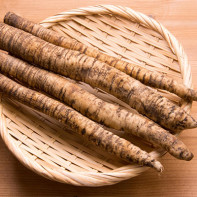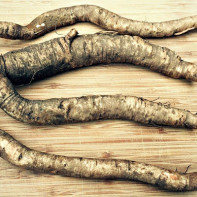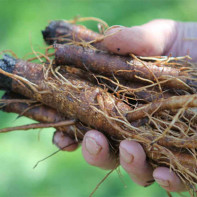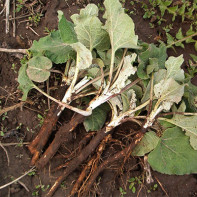Burdock root: medicinal properties and contraindications
Burdock - this is one of the most common plants, it can be found in vacant lots, along roads, and sometimes on a garden plot, if the territory is not well cared for. It is widely used both in official medicine and in folk medicine. Mainly as a medicinal raw material use the root of burdock, the leaves - much less often, since they contain fewer useful substances.
- What does the plant look like
- Where it grows
- Gathering and storage
- Chemical Composition
- Therapeutic properties of burdock root
- For Women
- For men
- In pregnancy
- For children
- When losing weight
- Burdock root in folk medicine
- For diabetes
- In pancreatitis
- For gastritis
- For bowel
- With constipation
- For gout
- For colitis
- For the liver
- For hemorrhoids
- For cholecystitis
- For cystitis
- For prostatitis
- For coughs
- For allergies
- For joints
- For mastopathy
- For oncology
- For parasites
- For Heart
- Dysbacteriosis
- Vascular Disease
- Kinds of medicinal compositions
- Infusion
- Infusion
- Decoction
- Tea
- Salve
- Oil
- Cosmetic Applications
- Burdock root for skin
- Burdock root for hair health
- Burdock root in cooking
- Contraindications for use
How does the plant look like?
There are several species of burdock, but the differences between them are minor. The most common is burdock - a herbaceous biennial that can reach a height of 0.6-1.8 m. The most notable part of it is the rather powerful root system of the rod type. The root of this plant is large and also thick, and it can reach 60 cm in length.
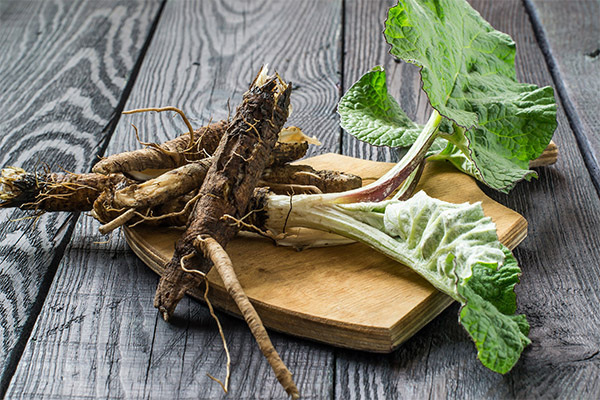
The stem of burdock is straight and ribbed, in the upper part it branches strongly. In the first year it forms only leaves, forming a root rosette. In the second year burdock should already be and straight stems, and ordinary leaves - large, smooth-edged, dark green above and grayish woolly outside.
Burdock blooms with purple-purple flowers collected in ball-shaped baskets. They reach a diameter of 30-40 mm, no more. This occurs in July and August. And in late summer and early fall, fruits appear, which are brown seeds.
Many people know and the second type of plant - burdock felt. It is more commonly referred to as burdock. It is also a biennial and has a long and fleshy root. Its leaves are large, but in general they are smaller than those of the large burdock described above. And the flowers of burdock, which have the ability of small prickles to cling to clothes, everyone knows.
Where does it grow
This plant is widely distributed throughout Eurasia in areas with a temperate climate. It is also found in Scandinavia, Britain and in the Mediterranean. Moreover, it came to Europe from Russia, where it is found throughout its territory, as far away as Siberia, the Middle East and the Far East. Burdock also occurs in Japan and China, and even in India. Relatively recently (by biological standards) burdock has been introduced to the North American continent and Latin America.
Under natural conditions, burdock can grow in the forest and among clusters of shrubs, but it prefers places closer to human habitation. That said, it often grows in littered or abandoned areas where the soil is rich in nitrogen.
Collection and storage
As a medicinal raw material can be used only the roots of burdock first year of life. The second year roots become woody and have almost no useful substances. You can distinguish the "first year" by the absence of flower stalks.
The roots should be dug in September-October, this is when they contain the greatest amount of useful substances. Roots are taken out carefully so as not to damage, digging the rosette to a fairly deep depth and taking into account the solid length. First, the dug root is given to dry out, then the remains of soil are scraped off it. Some herbalists believe that you can not wash the root, because together with water from the surface will run off and useful substances. But most modern herbalists believe that the root should still be washed with running water, dried, cut off at the root neck the part of the plant that sticks out above the ground, and only after that proceed to the drying process.
Since the roots of the plant are large, they are cut into pieces 5-10 cm long. And thick roots should also be divided in half lengthwise.
Dry the plant outdoors or indoors, provided that it is well ventilated. With high humidity, it is better to dry the roots in dryers, which are used for vegetables and fruits, choosing a gentle temperature mode of 45-50 degrees.
Dried roots stored in paper bags or cloth bags in a dark and dry place. Shelf life is 3 years. Some herbalists recommend storing the raw material in the form of powder, previously grinding it with a coffee grinder.
Can I freeze
Burdock root can be frozen. It does not lose its therapeutic properties. The roots are washed, plucked, dried, cut into pieces and placed in the freezer in special bags or plastic containers.
Chemical Composition
Burdock root is used as a medicinal raw material. But it also has nutritional value. Modern industry is considering the use of mashed burdock root as a raw material for the production of dietary products, including dairy products. And in the olden days the baked roots of the plant were used as food.
All the useful properties of burdock root due to its chemical composition. Not all of its constituent substances are studied to the end, but even today scientists believe that burdock is a treasure trove of useful elements. The composition of the root includes:
- Polysaccharide inulin (and its content is up to 45%). This substance is a prebiotic (thanks to him restores healthy microflora and improves the digestive process), is actively involved in metabolism. Thanks to inulin is better absorbed vitamins and minerals are removed toxins, adjusted carbohydrate metabolism, and therefore lowers blood sugar levels. This substance helps to strengthen the immune system.
- Essential badanum oil.
- Fatty acids (e.g. stearic and palmitic acids).
- Glycosides, which are necessary for normal digestion and cardiac function.
- Tannins.
- Sitosterol and stigmasterol are phytosterols, that is, substances that have the properties of hormones and can replace the artificial hormones used today (but without their side effects).
- Organic acids (including caffeic acid, which is known for its antioxidant and anti-inflammatory properties).
- A large amount of protein (up to 12%), which makes burdock root a valuable food item, especially since it resembles parsnips or parsley in taste.
- Ascorbic acid, which greatly improves vascular health and is an antioxidant.
- B vitamins that normalize the nervous system and participate in metabolic processes.
- Mineral salts, including calcium and potassium, without which it is impossible to work the heart muscle.
The root of all species of burdock has this composition. The difference lies mainly in the proportions and specific mass expression, but it is not too significant. In medicine, the most widespread is burdock large. This is due to the fact that it is more often found in nature, in addition, its root has a larger size.
From the above data, we can see that the most important components in the composition of burdock are fiber and dietary fiber, as well as proteins. Interestingly, many of the minerals are not contained in the core, but in the skin shell of the root. Therefore, when preparing medicines based on this raw material, it is not recommended to peel it.
Therapeutic properties of burdock root
Burdock root has a wide range of medicinal properties. In particular, it:
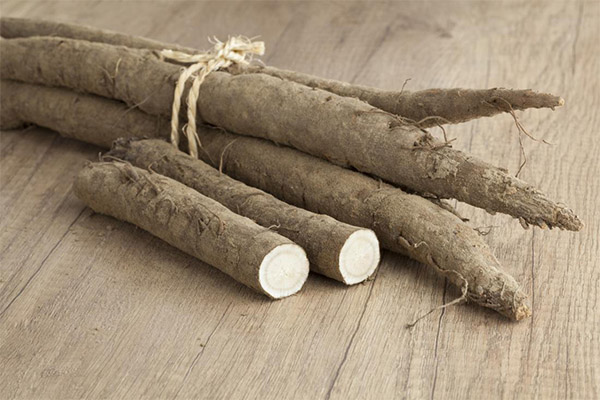
- Provides rapid tissue regeneration, which allows it to be used as a wound-healing agent.
- It has the ability to reduce blood sugar levels.
- Relieves inflammation.
- Promotes normal production of pancreatic enzymes.
- Acts as a mild laxative.
- It has antiseptic and bactericidal action.
- It has a choleretic effect and helps to normalize liver function.
- Normalizes digestive processes.
- A diuretic, which allows you to use it in diseases of the kidneys, as well as to eliminate swelling in other pathologies.
- Speeds up metabolic processes.
- Relieves itching with allergic reactions.
- Improves skin and hair.
- Has antipyretic properties, through which it is used in the treatment of colds (especially since burdock root also has a pronounced diaphoretic effect, and with viruses, it is important, because it allows you to quickly eliminate toxins).
It is clear that burdock root is inferior to modern antibiotics in its antibacterial action, and its analgesic effect will be weaker than that of nonsteroidal anti-inflammatory drugs. Therefore, in serious bacterial infections, it does not replace antibiotics, but is used as a means for complex therapy.
For women
For the fair sex, this remedy will be useful for several reasons at once. First, its anti-inflammatory properties help to fight various diseases of the pelvic organs. Secondly, the high content of phytosterols treats PMS, mastitis, improves the condition at menopause. And thirdly, the antioxidant properties of burdock can be used to combat wrinkles and to improve the skin.
For men
For members of the stronger sex, the anti-inflammatory properties of burdock root are most important, as they play a particularly important role in the treatment of prostatitis. However, a number of studies have shown that this plant contains components that can stop the growth of tissue characteristic of prostate adenoma, which is also very important. Finally, this plant eliminates constipation, which men suffer from more often than women.
Decoctions of burdock root and tea based on it also help to clear the blood vessels, which reduces the risk of the formation of cholesterol plaques and the development of CHD - another pathology, more typical for men.
In pregnancy.
Since there are currently no studies that would prove the safety of burdock root in pregnancy, many doctors advise to refrain from using products based on it. The root contains phytosterols that can affect the hormonal level of the expectant mother. However, this only applies to the use of preparations burdock internally. Use its decoctions to rinse hair during pregnancy is possible. This also applies to the lactation period, when the use internally is prohibited to avoid allergies.
For children
Children under the age of two years are contraindicated preparations based on burdock root. Later preschoolers are given extracts and decoctions for coughs, colds, allergies.
When losing weight
In dietetics, burdock root is used at once for several reasons. First, it is the presence of dietary fiber. They have the property to affect metabolic processes, speeding up the metabolism and improving the removal of toxins from the body. Interestingly, countries in the Pacific region, which are famous for the fact that obesity is rare for their residents, often add burdock root to various high-calorie dishes containing a lot of fat. Long before scientific studies were conducted, the people of these countries were aware that burdock root improves the absorption of such components. And modern science knows that this is due to inulin.
It is found in many plants, including Jerusalem artichoke. But burdock root is a record-breaker in this indicator. Inulin has a pleasant sweet taste and neutral odor. Burdock root itself also does not have a pronounced flavor, so it can be used in a variety of dietary dishes. Only 8-10 grams of inulin per day is enough to normalize blood sugar levels, improve metabolism and stimulate the development of bifidobacteria. This means that you need to eat 25-30 grams of burdock root. It can be used in stews or in salads, make jam on its basis according to the recipe below. Of course, limiting fats in this case will help to significantly increase the effectiveness of burdock for weight loss.
The root of this plant also has a diuretic effect, which allows you to remove excess fluid from the body. This also helps to reduce weight. You can drink a cup of burdock root tea every day to achieve this effect. It does not increase blood pressure and helps to clear the blood vessels, which is also good for health.
Burdock root in folk medicine
Burdock is used in folk medicine not only in Russia, but also in many other countries - Bulgaria, China, Japan. It is considered a good remedy for stomatitis, gout, bronchial asthma and even gynecological diseases.
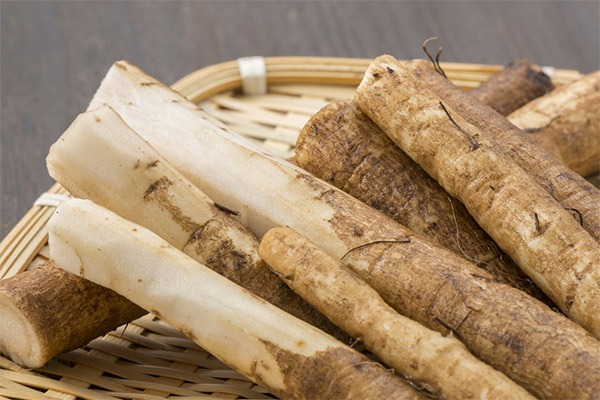
For diabetes.
Burdock root contains substances that help normalize blood sugar levels. Therefore, decoction of burdock root drink for type 2 diabetes. Prepare it this way - take 4 tbsp. chopped and pre-dried roots and pour 300 ml of boiling water, and then insist for two hours, preferably in a thermos (or just cover the container with a warm plaid decoction).
Drink the product three times a day after the main meal of 100 ml (1/2 cup). Before using the decoction must filter.
When pancreatitis
This disease is an inflammation of the pancreas. With acute pancreatitis you need to seek immediate medical attention, no decoctions should be drunk. But with a chronic disease, phytotherapy is quite acceptable (but only after consulting your doctor).
When pancreatitis take an infusion of burdock root. Prepare it this way - take 1 tbsp. dried crushed raw materials, pour 2 cups of boiling water, and then infused for two hours. Then bring the product to a boil, kept on low heat for 15 minutes and drink the cooled and strained infusion instead of tea three times a day for 100-120 ml.
With gastritis
The anti-inflammatory properties of burdock will also help with gastritis. In folk medicine, several recipes are popular. First, you can drink an infusion of burdock root. For its preparation take 1 tsp of crushed dried material, pour 200 ml of boiled water (but not hot and room temperature), insist means for 8 hours - it is best to leave it for the night. In the morning, strain the infusion and take 70 ml (about one-third cup) three times a day for half an hour before breakfast, lunch or dinner.
Some herbalists suggest preparing the infusion differently. Take 1 tsp of crushed dried root and pour 400 ml of boiling water. Infuse for 12 hours. The following day, strain the infusion and drink 100 ml 4 times a day before meals.
Second, with acute gastritis is recommended to use young burdock roots (from a plant of the first year of life), and in raw form. Some herbalists recommend eating 4-5 of these roots. Moreover, they must be fresh. They are used only for a day after they have been dug up, then they lose their useful properties. The duration of the treatment course is 2-3 weeks, then necessarily make a break.
Third, you can take a coffee grinded powder of dried burdock root, mix it in equal proportions with alcohol and honey and eat 1 tbsp. three times a day before the main meals.
For the bowel
In the treatment of ulcerative bowel disease, the same recipes are used as those given above for gastritis.
For constipation
The dietary fiber contained in burdock root makes it an excellent remedy for constipation caused by intestinal disorders. Therefore, to prevent constipation, it is recommended to add the root of the plant in the daily diet. You can also drink tea prepared according to the recipe below.
In case of gout.
This disease is caused by disorders of salt metabolism. Burdock will not be able to normalize it, but it will reduce the inflammation caused by it. So in this disease, it is used in combination therapy.
Prepare a remedy as follows. Take 1 tbsp. dried material and pour 0.6 liters of just boiling water, and then insist in a thermos (or a pot covered with a towel) for two hours. After that, the product is passed through any filter (you can use gauze) and drink 40 ml at least three times a day for 10-15 minutes before the main meals.
In colitis
Burdock leaves contain many components that make it effective against intestinal ulcers and colitis. But in the root of burdock, they are also present, albeit in slightly smaller amounts. For the treatment, take 1 tsp. dried roots, pour 0.4 liters of boiling water, insist overnight in a thermoc cup and drink 100 ml of infusion 4 times a day. The drink should be warm, because cold water will only aggravate the symptoms.
For the liver
The ingredients contained in burdock root make it not only a gastro- but also a hepatoprotector - a remedy useful for the liver cells (and even for the hepatobiliary system as a whole, since it has a choleretic action). In diseases of the liver take an infusion of burdock root. For its preparation take 4 tbsp. crushed dried material for 2 cups of boiling water. This remedy is infused overnight in an insulated container or thermocup, then brought to a boil, cooled to an acceptable temperature (so that it is not too hot, but well-warm) and strained. The resulting infusion is drunk a little at a time during the day.
Hemorrhoids
In this disease, it is very important to establish the digestive process. This helps to do prebiotic inulin, which is contained in the root of burdock. In addition, glycosides have a mild laxative effect and contribute to the normal process of defecation, which is very important in hemorrhoids. This plant has a pain-relieving effect - in the acute phase, it helps to alleviate unpleasant symptoms. Also burdock root relieves swelling, which helps to reduce inflammation. Finally, it is useful for strengthening blood vessels.
In such cases, take a decoction of burdock root, prepared according to the recipe below. The decoction can also be used as an undergarment - the salicylic acid it contains helps wounds heal faster.
For cholelithiasis
Since burdock root has a choleretic action, it is considered a good remedy for stagnant bile, provoked by this disease. But, in addition, it relieves inflammation, which is also very important in the treatment of cholecystitis. It is recommended in such cases to take decoction of burdock root. Prepare it this way - take 2 tbsp fresh or dried raw materials, pour a glass of boiling water and additionally heated not directly, but putting the container in a large saucepan with water. This is done for another 20 minutes. Then insist another half hour until it cools, filtered and drunk regardless of the meal, 1 tbsp. in the morning, lunch and evening (but not at night).
With cystitis
This is an inflammatory disease of the bladder, usually caused by a bacterial infection. Burdock relieves inflammation and allows you to eliminate disease-causing organisms. In addition, it has a diuretic effect, which allows faster removal of toxins and relieves the condition. But it is not used instead of antibiotics, but in combination with drugs prescribed by the doctor. It is recommended in this case to drink a decoction prepared according to the recipe below.
With prostatitis
The anti-inflammatory properties of burdock root allow you to use it as a remedy for prostatitis. To this end, prepare an infusion - 2 tbsp. chopped into small pieces of fresh root per glass of water at room temperature. The remedy is infused for two hours, bring to a boil, cool, pass through a fine strainer and take 100 ml three times a day. This recipe is considered effective with adenoma of the prostate.
With a cough
Infusion of burdock root, prepared according to the recipe below, is considered effective for gargling the throat for angina and other respiratory diseases. Such a procedure can be repeated every two hours.
With bronchitis and other diseases accompanied by cough, also use a decoction - 1 tsp of dried root per glass of boiling water. Before use, strain the product. Drink it 1 tbsp. 3-4 times a day. Decoction liquefies phlegm and helps to quickly remove it from the respiratory system.
From allergies
As you know, allergies are an autoimmune disease. It is impossible to cure it, but it is possible to minimize the risk of a strong reaction, and burdock copes well with this task. To do this, it is recommended to drink tea, prepared according to the recipe described below. Also decoction of burdock root helps to remove the manifestations of skin allergic reactions in diathesis.
For joints
In arthritis, rheumatism, inflammatory joint diseases burdock root is useful because it relieves swelling and fever, and has a bactericidal effect (and the cause of arthritis may well be an infection caused by pathogens). In addition, the plant has an anti-inflammatory effect.
It is possible with these diseases to take a decoction inside, cooked in a water bath in the same way as described above. It is also recommended to make an oil extract, impregnate gauze with it and apply a compress to the problem joint.
In mastopathy.
This disease is often caused by hormonal disorders. Included in the composition of burdock root phytosterols will help normalize the situation. Not without reason, this plant is included in many preparations. However, before its use it is still necessary to pass tests and consult with your doctor.
From mastopathy take a ready-made drugstore burdock root extract, following the manufacturer's instructions. But it is better to prepare the infusion yourself - for this, take 1 tbsp. dried burdock root, infused with a glass of just boiled water, leave it to cool for half an hour, and then drink during the day.
When oncology
The effectiveness of burdock root against cancer is not proven, but some researchers consider it a promising tool for prevention. In folk medicine for this purpose is a recipe - 10 grams of dried burdock root is crushed, add 1 tsp of flower honey, pour a glass of vodka and insist for 10 days in a dark and dry place, shaking the container with the drink occasionally. After this period of tincture is considered ready for use. For preventive purposes, it is recommended to take daily 15 ml of the means, diluted in ½ cup of water.
From parasites
Burdock root can get rid of worms. Take 1 tbsp. chopped burdock root and pour into a saucepan (enamel, so that the metal does not react with the plant material), and then pour a glass of boiling water and heat the mixture for 10 minutes, but do not bring to a boil. Then remove the pot from the fire and wrap with a terry towel or plaid, so as not to lose heat. In such conditions insist the remedy for half an hour, then strain. The decoction is drunk 50 ml three times a day, regardless of meals. Maximum effectiveness can be achieved if you simultaneously wash with this decoction every day.
For the heart
Contained in the burdock root substances help to normalize heart rhythm and improve heart function. To do this, dried young burdock root is ground in a coffee grinder to a powder. Then take 1 tsp. raw material and pour a glass of boiling water or hot milk. The remedy is cooled, it is no longer necessary to strain it. Use 1 tsp. three times a day before meals. Apply such an infusion course for 10-14 days, then a week make a break. To achieve the desired effect, repeat the course 2-3 times. Among other things, burdock root helps reduce "bad" cholesterol, which is often the cause of cardiovascular disease.
With dysbacteriosis
Dietary fiber, which is part of the burdock root, are prebiotics. That is, they create a favorable environment for the development of beneficial microflora, the lack of which provokes dysbiosis. It is therefore very useful to include in your diet burdock root, especially raw or boiled.
But they can be cooked from them only in the fall, and in dried form as a dietary supplement, they are not so useful. So the rest of the time to treat dysbacteriosis use decoction of burdock root and dandelion. Take these ingredients in equal proportions, mix, grind into powder, take 1 tbsp of raw materials, pour a glass of boiling water, once again bring to a boil and boil for 5 minutes. This remedy is drunk in place of tea in the morning or evening (only need to consider that it has a diuretic effect).
When vascular disorders.
Burdock root is considered an excellent remedy for the prevention and treatment of thrombophlebitis. But in such cases, its oil extract is used. Prepare it as follows. Take 40 grams of freshly dug roots and insist for a day in ½ cup vegetable oil (sunflower or olive). Then the resulting remedy for 15 minutes heated over low heat, strain and smear the problem area ready-made extract. Also make compresses - take a gauze napkin, soaked in the extract and applied at night to the sore spot, fixing it with a bandage.
Types of medicinal compositions
From burdock root make an alcoholic tincture, oil and water extract, decoction. There are many such recipes, below will be the most effective of them.
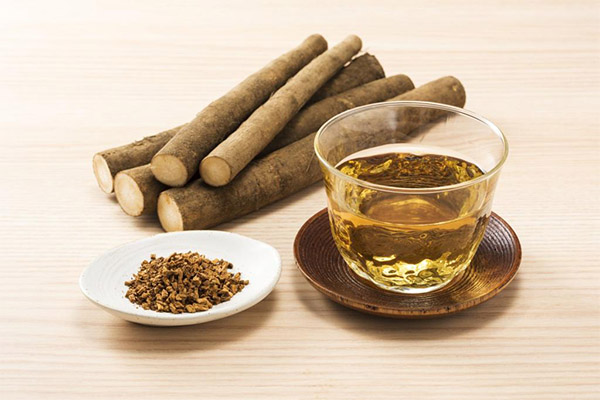
Infusion .
An aqueous infusion is prepared very simply - take 10-25 g of crushed dried roots (depending on how strong a concentration you want to get), pour 2 cups of boiling water and insist for an hour in a thermos. This remedy helps with gastritis, nephritis, some other kidney pathologies, cholecystitis and even gastric and intestinal ulcers. In such situations, it is drunk 100 ml no more than 3-4 times a day after the main meals. The duration of treatment is 20-50 days.
The infusion is also used as an external remedy. It relieves skin inflammation in exudative diathesis, heals wounds, disinfects problem areas with furunculosis. In this case, it is smeared on the affected skin or impregnated with compresses.
Tincture
In pharmacies you can find a ready-made alcohol extract of this plant, and at home prepare a tincture. For this purpose, either the freshly squeezed juice of the newly dug root, fresh or dry raw material, which is crushed beforehand, is used. The second option is considered more convenient. Burdock root and an alcoholic solution are taken in a ratio of 1:5. In this case, the crushed fresh root pour vodka or 40% alcoholic solution and put a container of this remedy in a dark cool place. There it was kept for two weeks, shaking occasionally, then filtered.
If you take a dry root, it already has a higher concentration of medicinal substances. Here, the proportion will be as follows - 20 g of raw materials per glass of vodka or alcohol solution. The algorithm of preparation will be the same. To improve the taste, honey is added to the tincture.
Decoction
Decoction of burdock root can be prepared in two ways. In the first version takes 15-20 grams of dried root, crush, pour a glass of water, boil and then simmer on low heat for another 20 minutes. Then cool for half an hour, strain and take 1 tbsp. daily three times after a meal. This is an excellent remedy not only for cholecystitis, but also for gout, diseases of the musculoskeletal system (such as osteochondrosis), cystitis.
In the second version takes 100 grams of crushed fresh raw materials, pour 1 liter of cold water, bring to a boil and keep on the fire so that has time to evaporate about half of the original volume. This remedy is strained, add honey to taste, and is used for diseases such as rheumatism and gout. Some herbalists also recommend it for exudative diathesis. But then honey should not be added, because it promotes sensitization of the body and aggravates the situation.
Tea .
In fact, this is a kind of herbal tea. To prepare it, take 1 tsp. dried root, brewed with a glass of boiling water and infused for 15 minutes. The concentration of medicinal ingredients in this drink is small. But it is considered a good preventive measure against colds.
Salve .
This product is prepared as follows - take 25 g of burdock root and as many of its leaves, crush, pour a glass of water, bring to a boil, then keep on low heat for another 20 minutes. Then the very plant raw materials and the liquid is pounded with 100 grams of unsalted butter or other fatty base. This remedy is good for healing wounds, they treat sores, burns and even frostbitten skin.
Oil
Contrary to the name itself, we are not talking about essential and fatty oils obtained from the root, but about its oil extract. To do this, take 75 grams of fresh raw materials, pour a glass of any refined vegetable oil and leave for a day. After that, the remedy is boiled for 15 minutes and strained. It is used mainly as an external remedy, including in cosmetology.
Cosmetic applications
The useful substances contained in the burdock root, allow you to apply it and in cosmetology, and it will be useful for both the skin and hair.
Burdock root for your skin
There are many effective recipes for home cosmetology. For example:
- Tonic for oily skin with enlarged pores. For his preparation take 10-20 grams of fresh burdock root, pour a glass of boiling water, infused for 20 minutes, then strain. This tonic wipe the skin after washing. It is also used for lotions - they impregnate a gauze napkin, which is attached to the skin for 10-15 minutes - we get an effective analogue of the popular today cloth masks.
- Lotion for oily skin. For its preparation take 2 tbsp. crushed dried raw materials, pour a glass of boiling water and leave over low heat for 10 minutes. The remedy cools to room temperature and strain. Then take 1 tbsp. of the resulting infusion of 100 ml. vodka or alcohol lotion. This product is rubbed over the skin twice a day instead of washing with the usual gels. Course duration - 2 weeks, otherwise there is a risk of over-drying the skin.
- Mask for problem skin prone to inflammation and acne rashes. As a rule, burdock leaves are used for this, which are simply applied to inflamed areas. But you can prepare a paste of boiled powder derived from the root of burdock, and use it as a mask.
You can also prepare an ointment for acne. It is effective when the individual pustules are formed. Prepare it this way - take 1 tbsp. dry root per glass of water, bring to a boil and then just keep on low heat until half of the liquid is evaporated from there. After that add unsalted ghee (4 parts to 1 part of the liquid) and mix thoroughly. The resulting ointment is applied to the problem areas of the skin.
Burdock root for hair health
In the old days, decoction of burdock root was considered the best remedy for hair loss. This property has proven and modern cosmetology - not without reason burdock root extract is added to many shampoos, balms and masks. This plant also helps to combat problems such as hair breakage and dryness.
Basically, the decoction is used to rinse after washing. For dry and normal hair, there are no restrictions for such a procedure, it can be used even daily, although in order to achieve the desired effect, it is enough to do it twice a week. It is important to carry out such a procedure for at least a month, then take a break.
For greasy hair there are restrictions - you can use the broth not more than once a week.
Infused burdock root as follows - take dried material, crush (but not to powder), take 2 Tbsp. of these pieces of root and pour 0.5 liters of hot water. Bring the product to a boil, then leave on low heat for another 15 minutes. Then remove from the stove, cool and strain.
Cooked according to this recipe decoction can be used in another way - instead of an elixir or tonic. To do this, the product is rubbed into the skin on a daily basis head massage. It is best to do this at night, so that you don't have to wash it off later. Here the treatment regimen will be different - a week of massage daily, the next week take a break. The treatment continues until there is a noticeable improvement.
Oil extract will help to cure seborrhea. It is also known as burdock oil, which can improve the condition of the hair. For its preparation take 100 grams of crushed fresh root and pour a glass of refined olive or sunflower oil. The remedy infused for a day, then boiled, and after cooling rubbed into the scalp 2-3 times a week. Leave the remedy for half an hour, then rinse thoroughly. To wake up the hair follicles, add a little red hot pepper (ground).
Burdock root use in cooking
The roots of burdock are also used in cooking. In some countries (eg, Japan) burdock even specially cultivated specifically for culinary purposes. Thus, the roots, ground to powder, added to the flour from which to bake bread.
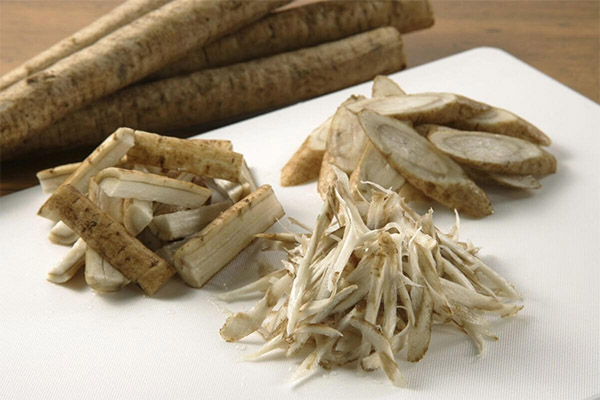
Burdock roots can be boiled, baked and fried. In salads, they are added fresh. They are also used to make puree and jam with a sour-sweet taste. In many dishes burdock roots can replace potatoes. They are even used to make tortillas and cutlets. And roasted roots replace chicory and serve as a coffee substitute.
Some dishes can help diversify the autumn menu (because digging up the roots in September):
- Vegetable Stew. Take 1 large root of burdock, boil for 10 minutes. Peel carrots and onions, chopped and fried in vegetable oil until half-cooked, then add chopped julienne bell peppers. Burdock root is also sliced, mixed with other vegetables, add salt, pepper and spices to taste and bring to a boil in a thick-bottomed saucepan. Serve as a side dish with meat or fish dishes.
- Jelly. At 1 kg of burdock roots take 1 liter of water and 50 ml of vinegar. Sugar is not necessary to add - this is its advantage. Vinegar essence is diluted with water according to the manufacturer's instructions, then brought to a boil, put there chopped in a blender burdock roots and cook over low heat for 2 hours. Ready jam spread on toast, also from it make marmalade and other useful sweets.
As for the coffee substitute, it is prepared as follows. Young roots are taken, washed, but not dried, and roasted in the oven until they acquire a brown hue. Then they are ground in a coffee grinder to a powder. To make a drink from them, take 1-2 tsp. of such powder per glass of boiling water. It tastes more like a drink made from chicory than natural coffee, but it also invigorates, and without the side effects that caffeine causes.
Contraindications for use
One of the advantages of burdock root as a remedy is that it has virtually no contraindications for use. One of them is hypersensitivity to its constituent substances. Therefore, in the first few times it should be used with caution.
Burdock root is contraindicated in pregnancy due to the fact that it contains phytosterols, and their effect on the mother's body during this period has not been studied. During lactation, it can not be used to avoid causing allergies in the baby. Children at the age of two years, preparations based on burdock root are also not given to avoid allergic reactions.
«Important: All information on this site is provided solely for informational purposes. Before applying any recommendations consult with a specialized specialist. Neither the editors nor the authors are liable for any possible harm caused by materials."

